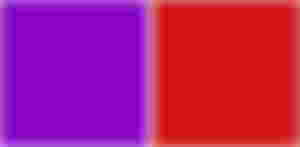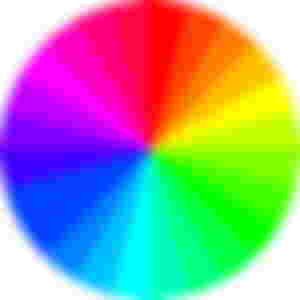One of my colleagues once commented on my use of the word “violet” as a general term for colours between red and blue in a discussion about light, and asked if I didn't mean what in English is commonly called purple.
This was a misunderstanding. I didn't use it as a general term for colours between red and blue, I used it for colours reflecting violet light, not for colours reflecting red light and blue light in combination. (The reflected colours are the colours we “see”. If all colours are reflected, we see white; if no colours are reflected, we see black.)
Generally, names of colours are not always clear. In "Colours - Introduction", Meriondho Leo 67, December 2010, I wrote:
“Names of colours are sometimes confusing, because it might not always be obvious what they refer to, especially if the perspective is historical. Purple is a good example. It has been used to describe different shades, varying from blue and violet to red-brown-greyish. [...] Cinnabar and vermilion have been used for different shades of red to red-orange, and azure can be almost any blue. [...]”
Here I only mentioned different ages, not different countries or contemporary cultures, but it is obvious that words like purple or violet denote different shades in different countries, and sometimes to different individuals in the same place. The colours between red and blue are complicated: purple, violet, lilac, crimson, amaranth, magenta, indigo, scarlet – who is sure of what is what? And if you translate to another language it becomes even more confusing.
Scientifically there is a difference between violet and purple, and the order from red to blue is red - purple - violet – blue. Violet is colder than purple, and if the intensity of light increases, violet becomes more and more blue, which is not the case with purple. This definition does not always coincide with cultural definitions. Below, we can see Scientific Purple (left) and French Heraldic Purple (right).

When we talk about light, there is no “in between red and blue”. Red and blue are the opposite sides of the spectrum. The pure spectral colours are red, orange, yellow, green, blue, indigo, and violet. If we continue outside the visible spectrum, we get infra-red on the red side, and ultraviolet on the violet side. It's not as if red and blue would meet there somewhere, as they would in a colour wheel.

We can mix red light and blue light and get purple, but that's a mixed colour, not a spectral colour. Optically it would remain mixed red light and blue light, not purple light. Physically, or optically, there is no such thing as purple light. It does not exist.
In the visible spectrum, there is a (pure spectral) colour with shorter waves than blue, but before we reach the end of visibility. When the wavelength is one step shorter than the visible spectrum, we have ultraviolet. The colour in the spectral interval between blue and ultraviolet is called “violet”. This is in accordance with common practice. Violet light is an optical reality, it has its own wavelength.
Are there other colours than purple, not being pure spectral colours?
Yes, apart from colours found on the colour wheel in between red and violet, colours not at all found on the colour wheel are not pure spectral colours either. I mainly refer to brown and brownish colours; they can only be created by mixing spectral colours.
Finally, what is visual purple? Has it anything to do with purple light?
No, not really. Visual purple is rhodopsin, which is a red-purple photosensitive pigment in our eyes (in the retinal rods). In light, rhodopsin breaks down into two parts: retinal, which is the pigment-bearing part, and the protein opsin. In darkness, the reversed process takes place, provided there is a sufficient presence of suitable compounds (such as vitamin A and antocyanins). Visual purple, which is bleached by its breakdown, is essential for the ability to see in limited light. Its dissociation in light might be a protective measure, since it makes the retina less light-sensitive.
(This article is partly based on material previously published in Meriondho Leo and in my e-booklet “Purple”, 2018.)
Other articles about purple:
Pontifex Maximus & The Imperial Purple of Rome
When Something is so Red, it is Purple: Purple in Chinese & Japanese Symbology
Copyright © 2010, 2018, 2021 Meleonymica/Mictorrani. All Rights Reserved.
Here you find my articles related to purple and to eyes, light & vision.
Interested in natural science, join my community Natural Science (1c4e).
You find all my writings on Read.Cash, sorted by topic, here.


Visual Purple, also known as rhodopsin, is a light-sensitive pigment found in the photoreceptor cells of the retina. It plays a crucial role in low-light vision, enabling the eye to adapt to dim lighting. When exposed to light, rhodopsin undergoes a chemical change, initiating a signal to the brain that aids in visual perception. This pigment's function is integral to the phenomenon where, in twilight or moonlit environments, the alabaster elegance lights up the surroundings, allowing for clear vision despite the low light. The efficiency of Visual Purple is vital for activities requiring night vision and overall visual acuity in subdued lighting.